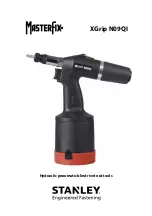
4.2.2.
To overcome this, connect a leader hose to the tool. A quick change coupling may then be used to connect the leader hose to the air
line recoil hose. See figs. 1 & 2.
5. OPERATION
WARNING!
Ensure that you read, understand and apply the safety instructions.
5.1.
Connect the tool to the air supply.
5.2.
To start the tool, hold firmly and squeeze the throttle lever. The clamp will move down, punching a hole/forming a flange, as required.
5.3.
Release the lever and the clamp will rise allowing the tool to be positioned for the next operation.
5.4.
After use, disconnect the tool from the air supply, clean and store in a safe, dry, childproof location.
6. MAINTENANCE
Note:
Numbers/letters in brackets refer to those on the parts diagram.
WARNING!
Disconnect the tool from the air supply before changing accessories, servicing or performing maintenance.
Replace or repair
damaged parts.
Use genuine parts only. Unauthorised parts may be dangerous and will invalidate the warranty.
6.1.
If the compressed air system does not have an integral oiler then lubricate the tool daily with a few drops of Sealey air tool oil dripped
into the air inlet.
6.2.
Regularly check oil, and top-up if necessary, via the oil plug (13). Use Sealey Air Tool Oil, Part No. ATO500S.
6.3.
Clean the tool after use.
6.4.
Loss of power or erratic action may be due to the following:
a) Excessive drain on the air line. Moisture or restriction in the air pipe. Incorrect size or type of hose connectors. To remedy, check
the air supply and follow instructions in Section 4.
b) Grit or gum deposits in the tool may also reduce performance. If your model has an air strainer (located in the area of the air inlet),
remove the strainer and clean it. Flush out the tool with gum solvent oil or an equal mixture of SAE 10 oil and paraffin. Allow to dry
before use.
6.5.
For a full service contact your local Sealey service agent.
6.6.
To remove and replace the punch (6) and/or die (3) proceed as follows:
6.6.1.
Remove screws (7) and slide off cover plate (8).
6.6.2.
Slacken set screw (2) and strike rear edge of clamp (1) with a soft-headed hammer in order to unscrew it from the shaft of the hydraulic
piston (31). If necessary the shaft may be locked by removing the oil plug (13) and inserting a suitable rod into a hole in the shaft.
6.6.3.
Fully unscrew the clamp (1) and anvil (9) assembly from the shaft.
6.6.4.
Separate the anvil (9) and the clamp (1) to replace the punch (6) and/or die. The die (3) is a push fit in the clamp (1) and can be tapped
out via the waste bore (A). Push/tap in the replacement.
6.6.5.
Reassemble the anvil (9), clamp (1) and the replacement punch (6) and screw onto the shaft. Tap with a soft-headed hammer
to ensure tightness and lock with the set screw (2).
6.6.6.
Refit the cover plate (8) and retain with screws (7).
WARNING! – Risk of Hand Arm Vibration Injury.
This tool may cause Hand Arm Vibration Syndrome if its use is not managed adequately.
This tool is subject to the vibration testing section of the Machinery Directive 2006/42/EC.
This tool is to be operated in accordance with these instructions.
Measured vibration emission value (a): 0.8 m/s²
Uncertainty value (k): 0.57 m/s²
Please note that the application of the tool to a sole specialist task may produce a different average vibration emission. We recommend
that a specific evaluation of the vibration emission is conducted prior to commencing with a specialist task.
A health and safety assessment by the user (or employer) will need to be carried out to determine the suitable duration of use for each
tool.
NB:
Stated Vibration Emission values are type-test values and are intended to be typical.
Whilst in use, the actual value will vary considerably from and depend on many factors.
Such factors include; the operator, the task and the inserted tool or consumable.
NB:
ensure that the length of leader hoses is sufficient to allow unrestricted use, as this also helps to reduce vibration.
The state of maintenance of the tool itself is also an important factor, a poorly maintained tool will also increase the risk of Hand Arm
Vibration Syndrome.
Health surveillance.
We recommend a programme of health surveillance to detect early symptoms of vibration injury so that management procedures can be
modified accordingly.
Personal protective equipment.
We are not aware of any personal protective equipment (PPE) that provides protection against vibration injury that may result from the
uncontrolled use of this tool. We recommend a sufficient supply of clothing (including gloves) to enable the operator to remain warm and
dry and maintain good blood circulation in fingers etc. Please note that the most effective protection is prevention, please refer to the
Correct Use and Maintenance section in these instructions. Guidance relating to the management of hand arm vibration can be found on
the HSC website
www.hse.gov.uk - Hand-Arm Vibration at Work.
Original Language Version
© Jack Sealey Limited
SA36.V2 Issue:4 (H,F) 13/07/21





















